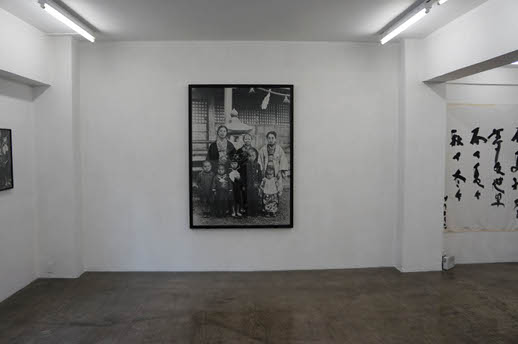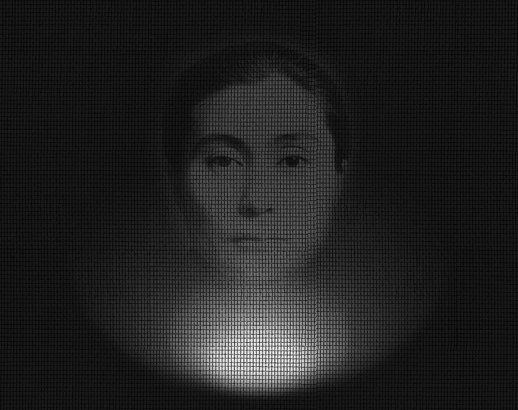Shining Light on Disaster
Following the presentation of the “Tragedy, Art, and Peace” talk at the Mori Art Museum in August this year, and the Yokohama Triennale that included her telephone installation, the prolific Yoko Ono has once again captivated Tokyo with new works. In not one but two exhibitions currently being displayed barely a few kilometers apart, Ono looks to address further the experience of trauma and loss, this time focusing on the mechanisms of remembrance and experience. Located in Gallery 360° is a show entitled “I WANT YOU TO REMEMBER ME”, whilst a few train stops west of this the “LIGHT” exhibition is running at Tomio Koyama Gallery. With these two shows there are some superficial as well as thematic similarities, but their approaches to a common subject deviate from each other profoundly.
Upon entering both gallery spaces, the first things you will notice in each show respectively are large, loosely painted black kanji characters vertically mounted or painted on white walls. Reportedly inscriptions of Ono’s hopes and thoughts, some of these characters are written so faintly that they are barely legible, whilst others are produced as a roughly continuous gesture, almost as a cursive script. In terms of the formal similarities, however, this is as far as the two exhibitions can be said to reference each other.

To address the “I WANT YOU TO REMEMBER ME” show first, aside from the calligraphy, the body of work is comprised from variously sized photographic portraits, each of which has been framed behind shattered panes of glass. The first portraits, clearly blown up from older, much smaller photographs, are of three women. On the adjacent wall a similar set of images, but this time of five children, confronts you. As you gaze through the fractured glass to the blurry images, you soon notice that the portraits appear to be roughly cropped and taken from a larger composition. Turning to the wall opposite, the full size, unedited portrait featuring all eight people can be viewed, though it is similarly enlarged and somewhat obscured behind splintered glass fragments.
According to Ono, this work is inspired by her own experiences of war, for it is known that she remained in Tokyo in March 1945 whilst the great fire-bombing took place. Though it is unclear whether the images featured are directly related to her, the point is that they offer the viewer windows through which to project their own feelings and experiences. We all have a past that we are able to connect with, and this inevitably includes troubling memories and recollections that these fragile portraits can help to draw out.
In contrast to this very personal and rather internalised approach, the “LIGHT” installation across town functions according to quite a different principle. On the first floor of the exhibition, where the calligraphy is located, there is a slightly raised platform covered back a tatty grey blanket in the centre of the room. On top of the blanket there is an arrangement of used objects. This work, entitled ‘Remnants’, includes articles taken from a house ravaged by the 2011 Great East Japan Earthquake, such as a cordless fan, a standing clock and a turntable. As indexical objects, these various items have the power to evoke memories relating to March 11 and the devastating aftermath. Be these memories first hand or third hand, they are equally valid and called upon by the physical presence of the objects, which actively work to reduce the distance between the viewer and the past event.

This connection to some kind of collective memory or experience is made very literal in the installation located two floors above, which is titled ‘To the Light’. As you remove your shoes and collect a torch, you are confronted by three dark corridors, the far left and right of which have their openings obstructed by black string curtains. Encouraged to enter the central passage, the first things you notice are the springy mesh walls which you must rely on to guide you around what turns out to be a maze. Located in the centre of this labyrinth is a bright white light that shines directly up at the ceiling. En route to making it to this middle point, and later to the outer parameter where other works are located, you find yourself receiving guidance from other viewers also searching their way through the narrow passageways. In return, you will almost certainly end up offering your own advice and gestures as to which direction to move in. It is this interactive element of the work and the concept of a shared event that is arguably what differentiates it from the other show. In some ways the cramped, dark space is quite uncomfortable, especially when there are many other people also struggling to move around the claustrophobic space. However, the metaphorical, and indeed literal, search for the light as a common event is entirely what makes the experience.
As in many of her works from the last five decades, both of these exhibitions by Ono implore their viewers to re-address traumatic or difficult histories and experiences, be they individual or shared, with a view to transcending the horror of them in order to achieve a more peaceful future. By using selected images, objects and physical experiences to stimulate and access such sites of internal suffering, Ono’s exhibitions are both cathartic and inspirational to partake in.
An additional or alternative work to these two temporary exhibitions is the ‘Wish Tree For Tokyo’ that is now permanently located in the sculpture garden of the Museum of Contemporary Art, Tokyo, a short walk from Tomio Koyama Gallery. You participate in this work by writing a wish and attaching it to the tree, though the single day each year that you are able to do this on, December 9, has just passed.
Jessica Jane Howard
Jessica Jane Howard



